RECSIT1.1中英文对照全文
recist俚语
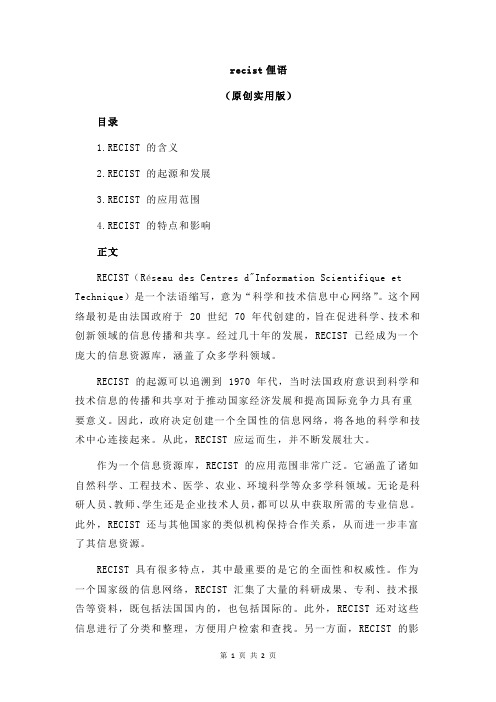
recist俚语(原创实用版)目录1.RECIST 的含义2.RECIST 的起源和发展3.RECIST 的应用范围4.RECIST 的特点和影响正文RECIST(Réseau des Centres d"Information Scientifique et Technique)是一个法语缩写,意为“科学和技术信息中心网络”。
这个网络最初是由法国政府于 20 世纪 70 年代创建的,旨在促进科学、技术和创新领域的信息传播和共享。
经过几十年的发展,RECIST 已经成为一个庞大的信息资源库,涵盖了众多学科领域。
RECIST 的起源可以追溯到 1970 年代,当时法国政府意识到科学和技术信息的传播和共享对于推动国家经济发展和提高国际竞争力具有重要意义。
因此,政府决定创建一个全国性的信息网络,将各地的科学和技术中心连接起来。
从此,RECIST 应运而生,并不断发展壮大。
作为一个信息资源库,RECIST 的应用范围非常广泛。
它涵盖了诸如自然科学、工程技术、医学、农业、环境科学等众多学科领域。
无论是科研人员、教师、学生还是企业技术人员,都可以从中获取所需的专业信息。
此外,RECIST 还与其他国家的类似机构保持合作关系,从而进一步丰富了其信息资源。
RECIST 具有很多特点,其中最重要的是它的全面性和权威性。
作为一个国家级的信息网络,RECIST 汇集了大量的科研成果、专利、技术报告等资料,既包括法国国内的,也包括国际的。
此外,RECIST 还对这些信息进行了分类和整理,方便用户检索和查找。
另一方面,RECIST 的影响也是不可忽视的。
它为法国的科研和产业发展提供了强大的信息支持,促进了科技创新和经济发展。
同时,RECIST 的成功经验也吸引了其他国家效仿,推动了全球范围内的信息资源共享。
总之,RECIST 作为一个科学和技术信息中心网络,在促进法国及全球范围内的信息传播和共享方面发挥了重要作用。
英国语文第一册-中英文对照(31-40-)

LESSON 31 THE GREAT JUMP第三十一课出色的一跳Ben and May were twins; that means that they were of the same age. May wa s not so tall asBen was, and she was not so strong; but May thought more, learned more, a nd did more than Ben.Ben和May是对双胞胎,因此他们同龄。
May没有Ben高,不强壮,但是比Ben更愿意去思考,去学习,去行动。
Ben could jump down one step of the stair at a time. When he held by the top of the rail, hecould jump two steps at a time. Ben was proud that he could jump more than May could.Ben 一次可以跳下一个台阶。
当他依靠栏杆顶部时可以一次跳两个台阶。
Ben很自豪可以比May跳的多。
When Ben and May were just four years old, Ben thought that he would soon be a big boy, fitfor school. He loved to talk, and he loved to boast, and so Ben said things whi ch no wise boy would have said.在Ben和May四岁那年,Ben觉得自己很快就是个大男孩了,适合上学了。
他喜欢说大话,喜欢吹牛,所以Ben就会说一些不聪明的男孩会说到的话。
''I can jump—I can jump a great way!〃cried Ben.''Now that I am four years old I can jumpdown four steps at a time, and not hold at all by the top of the rail!"''我能跳…我能出色的完成一跳!〃Ben大声喊道。
RECSIT1.1中英文对照全文

New response evaluation criteria in solid tumours: Revised RECIST guideline (version 1.1)新版实体瘤疗效评价标准:修订的RECIST指南(1.1版本)Abstract摘要Background背景介绍Assessment of the change in tumour burden is an important feature of the clinical evaluation of cancer therapeutics: both tumour shrinkage (objective response) and disease progression are useful endpoints in clinical trials. Since RECIST was published in 2000, many investigators, cooperative groups, industry and government authorities have adopted these criteria in the assessment of treatment outcomes. However, a number of questions and issues have arisen which have led to the development of a revised RECIST guideline (version 1.1). Evidence for changes, summarised in separate papers in this special issue, has come from assessment of a large data warehouse (>6500 patients), simulation studies and literature reviews.临床上评价肿瘤治疗效果最重要的一点就是对肿瘤负荷变化的评估:瘤体皱缩(目标疗效)和病情恶化在临床试验中都是有意义的判断终点。
【9A文】新标准大学英语视听说教程1-课文翻译
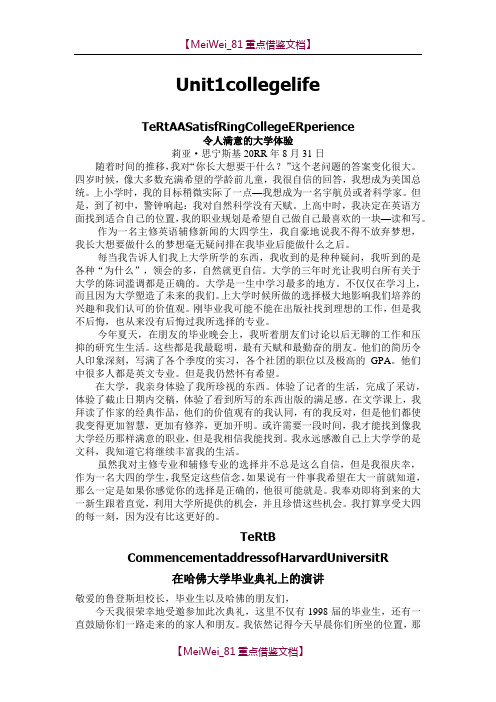
Unit1collegelifeTeRtAASatisfRingCollegeERperience令人满意的大学体验莉亚·思宁斯基20RR年8月31日随着时间的推移,我对“你长大想要干什么?”这个老问题的答案变化很大。
四岁时候,像大多数充满希望的学龄前儿童,我很自信的回答,我想成为美国总统。
上小学时,我的目标稍微实际了一点—我想成为一名宇航员或者科学家。
但是,到了初中,警钟响起:我对自然科学没有天赋。
上高中时,我决定在英语方面找到适合自己的位置,我的职业规划是希望自己做自己最喜欢的一块—读和写。
作为一名主修英语辅修新闻的大四学生,我自豪地说我不得不放弃梦想,我长大想要做什么的梦想毫无疑问排在我毕业后能做什么之后。
每当我告诉人们我上大学所学的东西,我收到的是种种疑问,我听到的是各种“为什么”,领会的多,自然就更自信。
大学的三年时光让我明白所有关于大学的陈词滥调都是正确的。
大学是一生中学习最多的地方。
不仅仅在学习上,而且因为大学塑造了未来的我们。
上大学时候所做的选择极大地影响我们培养的兴趣和我们认可的价值观。
刚毕业我可能不能在出版社找到理想的工作,但是我不后悔,也从来没有后悔过我所选择的专业。
今年夏天,在朋友的毕业晚会上,我听着朋友们讨论以后无聊的工作和压抑的研究生生活。
这些都是我最聪明,最有天赋和最勤奋的朋友。
他们的简历令人印象深刻,写满了各个季度的实习,各个社团的职位以及极高的GPA。
他们中很多人都是英文专业。
但是我仍然怀有希望。
在大学,我亲身体验了我所珍视的东西。
体验了记者的生活,完成了采访,体验了截止日期内交稿,体验了看到所写的东西出版的满足感。
在文学课上,我拜读了作家的经典作品,他们的价值观有的我认同,有的我反对,但是他们都使我变得更加智慧,更加有修养,更加开明。
或许需要一段时间,我才能找到像我大学经历那样满意的职业,但是我相信我能找到。
我永远感激自己上大学学的是文科,我知道它将继续丰富我的生活。
大学体验英语体验英语第一册课文逐句翻译

体验英语课文逐句翻译So Much to Learn学无止境It was the last day of final examinations in a large Eastern university. On the steps of one building, a group of engineering seniors huddled, discussing the exam due to begin in a few minutes. On their faces was confidence. This was their last exam before they went on to commencement and jobs.故事发生在一所东部大学里。
那是终考的最后一天。
一幢教学楼的台阶上围着一群大四的工科生,都在谈论即刻就要开始的考试。
他们脸上都带着自信。
这是毕业前的最后一场考试了,考完后,即是毕业典礼。
然后他们将各奔前程。
Some talked of jobs they already had; others of jobs they would get. With all this assurance of four years of college study, they felt ready and able to conquer the world.话题转到了工作上,有的谈起了找好的工作,有的则谈论着要找的工作。
4年的大学学习给了他们自信,使他们觉得自己足以征服世界。
The approaching exam, they knew, would be a snap. The professor had said they could bring any books or notes they wanted, requesting only that they did not talk to each other during the test.眼前这场考试,不过是一碟小菜罢了。
新版大学英语第二版综合教程第1课文对照翻译
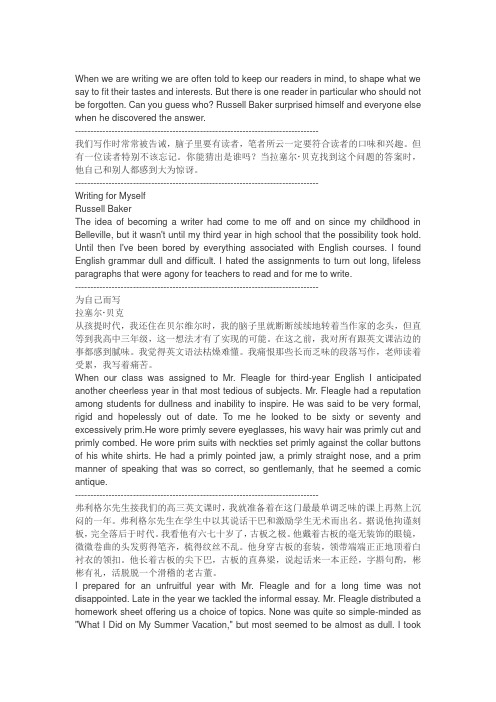
When we are writing we are often told to keep our readers in mind, to shape what we say to fit their tastes and interests. But there is one reader in particular who should not be forgotten. Can you guess who? Russell Baker surprised himself and everyone else when he discovered the answer.--------------------------------------------------------------------------------我们写作时常常被告诫,脑子里要有读者,笔者所云一定要符合读者的口味和兴趣。
但有一位读者特别不该忘记。
你能猜出是谁吗?当拉塞尔·贝克找到这个问题的答案时,他自己和别人都感到大为惊讶。
--------------------------------------------------------------------------------Writing for MyselfRussell BakerThe idea of becoming a writer had come to me off and on since my childhood in Belleville, but it wasn't until my third year in high school that the possibility took hold. Until then I've been bored by everything associated with English courses. I found English grammar dull and difficult. I hated the assignments to turn out long, lifeless paragraphs that were agony for teachers to read and for me to write.--------------------------------------------------------------------------------为自己而写拉塞尔·贝克从孩提时代,我还住在贝尔维尔时,我的脑子里就断断续续地转着当作家的念头,但直等到我高中三年级,这一想法才有了实现的可能。
走遍法国Reflets1下21课中文翻译

第21课:一次意外的顶替早上九点。
Benoit走进他的办公室。
他刚一坐下电话就响了。
Benoit:好时光开始了!喂?Nicole:喂,Benoit。
我是Nicole。
你看到你桌上的那个盒子了吗?Benoit:没有,我刚到。
那是什么?Nicole:(画面外)如果你打开的快的话,你会知道。
我相信你会喜欢。
Benoit:好的!Benoit打开盒子。
Benoit走进Nicole的办公室,看起来有点开心。
他手里拿着手机。
Benoit:手机?为了什么?Nicole:领导的命令。
这样,大家可以更方便的找到你。
Benoit:这样啊,那我白天晚上都要工作了!Nicole:你还忘了礼拜六和礼拜天!你知道怎么用吗?Benoit:我一会学。
Nicole:很好。
Richard刚打来电话。
他病了。
他不能负责巴西城市设计师了。
你去他的位子,带他们参观La Defense。
Benoit:好的。
但是我对La Defense一点都不了解。
Nicole:这是资料。
你在去的路上读一下。
这是个信任任务。
我们的拜访者M.Costa,是巴西城市建筑研究所的领导。
他带着他的2个最好的学生来。
你和他们的约会时间是10点半,在La Defense广场,在Miro人像旁边。
这可是广场上最大的雕塑。
它是红色,黄色和蓝色的。
你不可能找不到。
Benoit在Miro人像旁。
他没看到巴西人。
他停下来拿出他的手机。
Benoit:喂,Richard?我现在在La Defense 广场上,在Miro人像旁。
我刚转了一圈,我什么人都没看到……Calder?Calder雕塑?是,是,我看到了。
好的,如果你确定的话,我过去。
我希望他们还在那儿……什么?你又有个电话进来了?好的,我等着,但是快点啊!一个男人,M.Costa,在雕塑旁讲电话M.Costa:我只是想知道你的同事没出什么事吧。
或者我把约会的地点弄错了?啊,如果他在线上,这很好。
好,我等着。
Benoit来到M.Costa旁边重新继续刚才的交谈。
新标准大学英语 综合教程1 课文翻译讲解

新标准英语 1 课文翻译Unit 1大一新生日记星期日从家里出发后,我们开车开了很长一段时间才到达我住的宿舍楼。
我进去登记。
宿舍管理员给了我一串钥匙,并告诉了我房间号。
我的房间在6楼,可电梯坏了。
等我们终于找到8号房的时候,妈妈已经涨红了脸,上气不接下气。
我打开门锁,我们都走了进去。
但爸爸马上就从里面钻了出来。
这个房间刚刚够一个人住,一家人都进去,肯定装不下。
我躺在床上,不动弹就可以碰到三面墙。
幸亏我哥哥和我的狗没一起来。
后来,爸爸妈妈就走了,只剩下我孤零零一个人。
周围只有书和一个箱子。
接下来我该做什么?星期一早上,有一个为一年级新生举办的咖啡早茶会。
我见到了我的导师,他个子高高的,肩膀厚实,好像打定了主意要逗人开心。
“你是从很远的地方来的吗?”他问我。
他边说话边晃悠脑袋,咖啡都洒到杯托里了。
“我家离爱丁堡不太远,开车大约6个小时,”我说。
“好极了!”他说,接着又走向站在我旁边的那个女孩儿。
“你是从很远的地方来的吗?”他问。
但不等那女孩儿作出任何回答,他就说到,“好极了!”然后就继续向前走。
他啜了一口咖啡,却惊讶地发现杯子是空的。
妈妈打来电话。
她问我是不是见到了导师。
星期二我觉得有点儿饿,这才意识到我已经两天没吃东西了。
我下楼去,得知一天三餐我可以在餐厅里吃。
我下到餐厅排进了长队。
“早餐吃什么?”我问前面的男生。
“不知道。
我来得太晚了,吃不上早餐了。
这是午餐。
”午餐是自助餐,今天的菜谱是鸡肉、米饭、土豆、沙拉、蔬菜、奶酪、酸奶和水果。
前面的男生每样儿都取一些放到托盘上,付了钱,坐下来吃。
我再也不觉得饿了。
妈妈打电话来。
她问我有没有好好吃饭。
星期三早上9点钟我要去听一个讲座。
我醒时已经8:45了。
竟然没有人叫我起床。
奇怪。
我穿好衣服,急匆匆地赶到大讲堂。
我在一个睡眼惺忪的女生旁边坐下。
她看了看我,问:“刚起床?”她是怎么看出来的?讲座进行了1个小时。
结束时我看了看笔记,我根本就看不懂自己写的字。
那个女生名叫苏菲,和我一样,也是英语文学专业的学生。
新标准大学生英语综合教程第一册全部课文翻译资料

Unit1 为自己而写从孩提时代,我还住在贝尔维尔时,我的脑子里就断断续续地转着当作家的念头,但直等到我高中三年级,这一想法才有了实现的可能。
在这之前,我对所有跟英文课沾边的事都感到腻味。
我觉得英文语法枯燥难懂。
我痛恨那些长而乏味的段落写作,老师读着受累,我写着痛苦。
弗利格尔先生接我们的高三英文课时,我就准备着在这门最最单调乏味的课上再熬上沉闷的一年。
弗利格尔先生在学生中以其说话干巴和激励学生无术而出名。
据说他拘谨刻板,完全落后于时代。
我看他有六七十岁了,古板之极。
他戴着古板的毫无装饰的眼镜,微微卷曲的头发剪得笔齐,梳得纹丝不乱。
他身穿古板的套装,白衬衣领扣外的领带打得——丝不苟。
他有着古板的尖下巴,古板的直鼻梁,说起话来—本正经,字斟句酌,彬彬有礼,活脱脱一个滑稽的老古董。
我作好准备,打算在弗利格尔先生的班上一无所获地混上一年,不少日子过去了,还真不出所料。
后半学期我们学写随笔小品文。
弗利格尔先生发下一张家庭作业纸,出了不少题供我们选择。
像“暑假二三事”那样傻乎乎的题目倒是一个也没有,但绝大多数—样乏味。
我把作文题带回家,—直没写,直到要交作业的前一天晚上。
我躺在沙发上,最终不得不面对这一讨厌的功课,便从笔记本里抽出作文题目单粗粗—看。
我的目光落在“吃意大利细面条的艺术”这个题目上。
这个题目在我脑海里唤起了一连串不同寻常的图像。
贝尔维尔之夜的清晰的回忆如潮水一般涌来,当时,我们大家一起围坐在晚餐桌旁——艾伦舅舅、我母亲、查理舅舅、多丽丝、哈尔舅舅、帕特舅妈晚饭做的是意大利细面条。
那时意大利细面条还是很少听说的异国食品。
多丽丝和我都还从来没吃过,在座的大人也是经验不足,没有—个吃起来得心应手的。
艾伦舅舅家诙谐有趣的场景全都重现在我的脑海中,我回想起来,当晚我们笑作—团,争论着该如何地把面条从盘子上送到嘴里才算合乎礼仪。
突然我就想描述那一切,描述当时那种温馨美好的气氛,但我把它写下来仅仅是想自得其乐,而不是为弗利格尔先生而写。
高职国际进阶英语综合教程unit1课文原文和译文

高职国际进阶英语综合教程unit1课文原文和译文高职国际进阶英语综合教程unit1课文原文和译文Text A Barbecue partySung Ling from Shanghai is staying with her exchange partner, Kate Miller, in San Francisco.On Ling’s first Saturday, the Millers have a barbecue in their garden. They want to introduce Ling to some of their neighbours. Kate also invites some of her friends from school.Before the barbecue, Ling is a little nervous. “What do I say when you introduce me to somebo dy?” she asks Kate.“Don’t worry, Ling,” Kate says. “It’s very easy. When I introduce you to an older person, for example Grant Summers, our next-door neighbour, I say, ‘Grant, this is Sung Ling from Shanghai. She’s my exchange partner.’ And then I say to you, ‘Ling, this is Grant Summers. He’s our next-door neighbour.’ And you just say, ‘How do you do, Mr Summers? It’s nice to meet you.’”“Yes, but do I shake hands or just smile?”“Well, with an older person you can shake hands and smile. But remember that in America, we like a firm handshake.”“Okay, Kate,” Ling says, “but what about when I want to introduce myself? Maybe you won’t be there.”“Well, if it’s an older person –Grant’s wife, Susan, for example –you just offer your hand and say, ‘How do you d o? I’m Sung Ling from Shanghai. I’m Kate’s exchange partner.’”“And what will the other person say?” Ling asks.“Well, the other person will also say ‘How do you do?’ and tell you his or her name.”“Okay. I’ve got that. But what about younger people? Youk now, your friends from school.”“Well, just say, ‘Hi, I’m Ling, Kate’s exchange partner.’ It’s very informal.”“And what about people I already know?”“Well, if you see somebody you know after a short time, just say ‘Hello.’ But if you see them after a lon ger time, then you say, ‘How are you?’ or maybe ‘How are things?’”“And what do I answer if somebody greets me with ‘How are you, Ling?’”“Just say ‘Fine, thanks. And you?’ Then the other person says, ‘I’m fine, too. Thanks.’”“Okay. But I thought you said it’s very easy.”译文:上海来的宋玲与她的交换伙伴凯特·米勒一起住在旧金山。
大学体验英语综合教程1第二版课文翻译【免费】详解
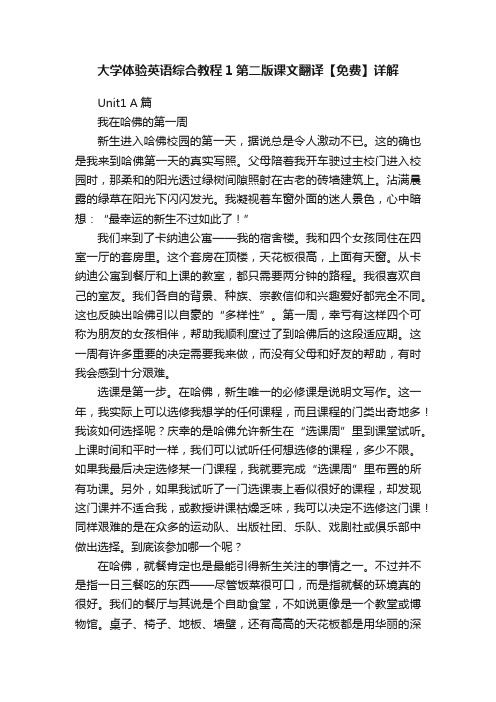
大学体验英语综合教程1第二版课文翻译【免费】详解Unit1 A篇我在哈佛的第一周新生进入哈佛校园的第一天,据说总是令人激动不已。
这的确也是我来到哈佛第一天的真实写照。
父母陪着我开车驶过主校门进入校园时,那柔和的阳光透过绿树间隙照射在古老的砖墙建筑上。
沾满晨露的绿草在阳光下闪闪发光。
我凝视着车窗外面的迷人景色,心中暗想:“最幸运的新生不过如此了!”我们来到了卡纳迪公寓——我的宿舍楼。
我和四个女孩同住在四室一厅的套房里。
这个套房在顶楼,天花板很高,上面有天窗。
从卡纳迪公寓到餐厅和上课的教室,都只需要两分钟的路程。
我很喜欢自己的室友。
我们各自的背景、种族、宗教信仰和兴趣爱好都完全不同。
这也反映出哈佛引以自豪的“多样性”。
第一周,幸亏有这样四个可称为朋友的女孩相伴,帮助我顺利度过了到哈佛后的这段适应期。
这一周有许多重要的决定需要我来做,而没有父母和好友的帮助,有时我会感到十分艰难。
选课是第一步。
在哈佛,新生唯一的必修课是说明文写作。
这一年,我实际上可以选修我想学的任何课程,而且课程的门类出奇地多!我该如何选择呢?庆幸的是哈佛允许新生在“选课周”里到课堂试听。
上课时间和平时一样,我们可以试听任何想选修的课程,多少不限。
如果我最后决定选修某一门课程,我就要完成“选课周”里布置的所有功课。
另外,如果我试听了一门选课表上看似很好的课程,却发现这门课并不适合我,或教授讲课枯燥乏味,我可以决定不选修这门课!同样艰难的是在众多的运动队、出版社团、乐队、戏剧社或俱乐部中做出选择。
到底该参加哪一个呢?在哈佛,就餐肯定也是最能引得新生关注的事情之一。
不过并不是指一日三餐吃的东西——尽管饭菜很可口,而是指就餐的环境真的很好。
我们的餐厅与其说是个自助食堂,不如说更像是一个教堂或博物馆。
桌子、椅子、地板、墙壁,还有高高的天花板都是用华丽的深色木料制作的,油漆得精光锃亮。
而且,大厅里悬挂着枝形吊灯,墙上镶嵌着明亮的彩色玻璃窗,厅里到处可见哈佛历史名人的雕塑和画像。
英雄无敌III地图名中英文对照
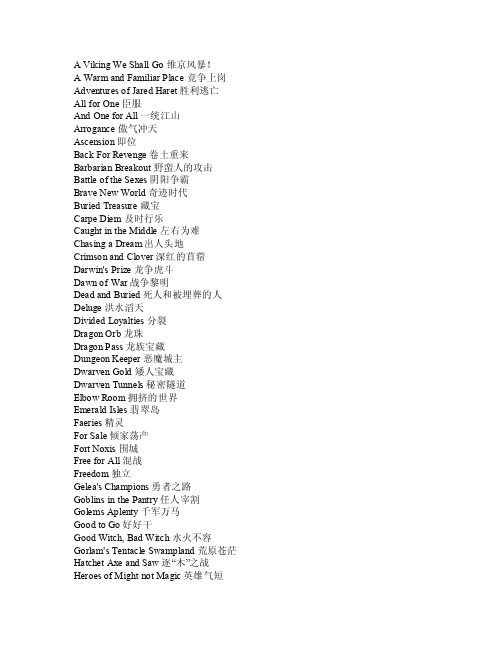
A Viki ng We Shal l Go维京风暴!AWarmand F amili ar Pl ace 竞争上岗Adve nture s ofJared Hare t 胜利逃亡A ll fo r One臣服AndOne f or Al l 一统江山A rroga nce 傲气冲天Asce nsion即位Back ForReven ge 卷土重来Barba rianBreak out 野蛮人的攻击Ba ttleof th e Sex es 阴阳争霸Brave NewWorld奇迹时代Bu riedTreas ure 藏宝C arpeDiem及时行乐Cau ght i n the Midd le 左右为难Chasi ng aDream出人头地Cr imson andClove r 深红的苜蓿Darwi n's P rize龙争虎斗Daw n ofWar 战争黎明Dead andBurie d 死人和被埋葬的人De luge洪水滔天Div idedLoyal ties分裂Drago n Orb龙珠Drag on Pa ss 龙族宝藏Dunge on Ke eper恶魔城主Dwa rvenGold矮人宝藏Dwa rvenTunne ls 秘密隧道Elbow Room拥挤的世界E meral d Isl es 翡翠岛F aerie s 精灵For Sale倾家荡产Fo rt No xis 围城F ree f or Al l 混战Fre edom独立Gelea's Ch ampio ns 勇者之路Gobli ns in thePantr y 任人宰割G olems Aple nty 千军万马Good to G o 好好干Go od Wi tch,Bad W itch水火不容Gor lam's Tent acleSwamp land荒原苍茫Hat chetAxe a nd Sa w 逐“木”之战Hero es of Migh t not Magi c 英雄气短H oard兵来将挡Hol d the midd le 坚持到底Irrat ional Host ility征服者Isl and K ing 骨肉相残Isla nd of Fire火岛Isla nds a nd Ca ves 岛屿与洞穴Jih ad 战争风暴Judge mentDay 审判之日Just A Vi sit 真命天子Keyto Vi ctory取胜的关键K ing o f Pai n 丧心病狂K ingdo m for sale购买领土Kn ee De ep in theDead救世主Knig ht of Dark ness黑暗骑士Lan d ofTitan s 泰坦大陆L ast C hance殊死一搏Lo ss of Inno cence和平的希望M anife st De stiny宿命Mars hland Mena ce 远古封印Meeti ng in Muzg ob 乱世英雄Merch ant P rince s 尔虞我诈M iddle town中心城Monk's Re treat负隅顽抗No ahs A rk 诺亚方舟Overt hrowThy N eighb ors 好事多磨Pand ora's Box潘多拉之盒Pe acefu l End ing 重归于好Peac emake r 和事佬Pe stile nce L ake 归隐田园Pira tes 海盗!Racefor A rdint inny争夺阿第尼城R ace f or th e Tow n 比武招亲R eadyor No t 一触即发R ealmof Ch aos 混乱的国土Reb ellio n 反叛Rec lamat ion 重归故土Redi scove ry 征战不休Resou rce W ar 各取所需Riseof th e Pho enix凤凰涅磐Rum ble i n the Bogs沼泽地里的声音Sand s ofBlood碧血黄沙Sa ngraa l's T hief妙手空空Sea rch f or th e Gra il 搜寻神器Serpe nts T reasu re 毒蛇的财宝Shad ow Va lleys瓮中捉鳖So uth o f Hel l 地狱恶魔S outhe rn Cr oss 越过南海Step by S tep 步步紧逼Tale of t wo la nds 野心之战Terr ibleRumor谣言惑众Th e Bat tle o f Dae yan's Ford惊天一战Th e Cha lleng e 放手一搏T he Fi ve Ri ngs 五环之战TheGaunt let 考验T he Gr eat R ace 生死时速TheManda te of Heav en 天堂之令The N ewcom ers 寸土必争Thou sandIslan ds 千岛之战Time's Up英雄本色Tit ans W inter泰坦的冬天T oo Ma ny Mo nster s 兽性大发T ovar's For tress海盗的财宝T reasu re Hu nt 争夺矿产Twins双胞胎Und ead U nrest消灭亡灵Un expec ted I nheri tance继承人Unh oly Q uest可怕的远征Va lleys of W ar 远征Vi al of Life生命之瓶Wa r ofthe M ighty先发制人Wa rlord s 群雄逐鹿W armon gers战争贩子Whe n Dra gonsClash龙族的纷争W ingsof Wa r 战争之翼X athra s Pri ze 泽沙思的悬赏AVikin g WeShall Go 维京风暴!A W arm a nd Fa milia r Pla ce 竞争上岗Adven tures of J aredHaret胜利逃亡Al l for One臣服And O ne fo r All一统江山Ar rogan ce 傲气冲天Ascen sion即位BackFor R eveng e 卷土重来B arbar ian B reako ut 野蛮人的攻击Bat tle o f the Sexe s 阴阳争霸B raveNew W orld奇迹时代Bur ied T reasu re 藏宝Ca rpe D iem 及时行乐Caug ht in theMiddl e 左右为难C hasin g a D ream出人头地Cri msonand C lover深红的苜蓿D arwin's Pr ize 龙争虎斗Dawn of W ar 战争黎明Deadand B uried死人和被埋葬的人Del uge 洪水滔天Divi ded L oyalt ies 分裂D ragon Orb龙珠Drago n Pas s 龙族宝藏D ungeo n Kee per 恶魔城主Dwar ven G old 矮人宝藏Dwar ven T unnel s 秘密隧道E lbowRoom拥挤的世界Em erald Isle s 翡翠岛Fa eries精灵ForSale倾家荡产For t Nox is 围城Fr ee fo r All混战Free dom 独立G elea's Cha mpion s 勇者之路G oblin s inthe P antry任人宰割Go lemsAplen ty 千军万马Goodto Go好好干Goo d Wit ch, B ad Wi tch 水火不容Gorl am'sTenta cle S wampl and 荒原苍茫Hatc het A xe an d Saw逐“木”之战Heroe s ofMight notMagic英雄气短Ho ard 兵来将挡Hold themiddl e 坚持到底I rrati onalHosti lity征服者Isla nd Ki ng 骨肉相残Islan d ofFire火岛Islan ds an d Cav es 岛屿与洞穴Jiha d 战争风暴J udgem ent D ay 审判之日JustA Vis it 真命天子Key t o Vic tory取胜的关键Ki ng of Pain丧心病狂Ki ngdom forsale购买领土Kne e Dee p inthe D ead 救世主Knigh t ofDarkn ess 黑暗骑士Land of T itans泰坦大陆La st Ch ance殊死一搏Los s ofInnoc ence和平的希望Ma nifes t Des tiny宿命Marsh landMenac e 远古封印M eetin g inMuzgo b 乱世英雄M ercha nt Pr inces尔虞我诈Mi ddlet own 中心城Monk's Ret reat负隅顽抗Noa hs Ar k 诺亚方舟O verth row T hy Ne ighbo rs 好事多磨Pando ra'sBox 潘多拉之盒Pea ceful Endi ng 重归于好Peace maker和事佬Pes tilen ce La ke 归隐田园Pirat es 海盗!R ace f or Ar dinti nny 争夺阿第尼城Ra ce fo r the Town比武招亲Re ady o r Not一触即发Re alm o f Cha os 混乱的国土Rebe llion反叛Recl amati on 重归故土Redis cover y 征战不休R esour ce Wa r 各取所需R ise o f the Phoe nix 凤凰涅磐Rumb le in theBogs沼泽地里的声音Sands of B lood碧血黄沙San graal's Th ief 妙手空空Sear ch fo r the Grai l 搜寻神器S erpen ts Tr easur e 毒蛇的财宝Shado w Val leys瓮中捉鳖Sou th of Hell地狱恶魔So uther n Cro ss 越过南海Stepby St ep 步步紧逼Taleof tw o lan ds 野心之战Terri ble R umor谣言惑众The Batt le of Daey an'sFord惊天一战The Chal lenge放手一搏Th e Fiv e Rin gs 五环之战The G auntl et 考验Th e Gre at Ra ce 生死时速The M andat e ofHeave n 天堂之令T he Ne wcome rs 寸土必争Thous and I sland s 千岛之战T ime's Up 英雄本色Tita ns Wi nter泰坦的冬天To o Man y Mon sters兽性大发To var's Fort ress海盗的财宝Tr easur e Hun t 争夺矿产T wins双胞胎Unde ad Un rest消灭亡灵Une xpect ed In herit ance继承人Unho ly Qu est 可怕的远征Val leysof Wa r 远征Via l ofLife生命之瓶War of t he Mi ghty先发制人War lords群雄逐鹿Wa rmong ers 战争贩子When Drag ons C lash龙族的纷争Wi ngs o f War战争之翼Xa thras Priz e 泽沙思的悬赏。
场效应管的分类

场效应管的分类场效应管(FET)是一种电压控制电流器件。
其特点是输入电阻高,噪声系数低,受温度和辐射影响小。
因而特别使用于高灵敏度、低噪声电路中。
场效应管的种类很多,按结构可分为两大类:结型场效应管(JFET)和绝缘栅型场效应管(IGFET).结型场效应管又分为N沟道和P沟道两种。
绝缘栅场效应管主要指金属--氧化物--半导体场效应管(MOS管)。
MOS管又分为“耗尽型”和“增强型”两种,而每一种又分为N沟道和P 沟道。
结型场效应管是利用导电沟道之间耗尽区的宽窄来控制电流的,输入电阻(105~1015)之间;绝缘栅型是利用感应电荷的多少来控制导电沟道的宽窄从而控制电流的大小,其输入阻抗很高(栅极与其它电极互相绝缘)。
它在硅片上的集成度高,因此在大规模集成电路中占有极其重要的地位。
场效应管的型号命名方法现行场效应管有两种命名方法。
第一种命名方法与双极型三极管相同,第三位字母J代表结型场效应管,O代表绝缘栅场效应管。
第二位字母代表材料,D是P型硅,反型层是N沟道;C是N型硅P沟道。
例如,3DJ6D 是结型N沟道场效应三极管,3DO6C 是绝缘栅型N沟道场效应三极管。
第二种命名方法是CS××#,CS代表场效应管,××以数字代表型号的序号,#用字母代表同一型号中的不同规格。
例如CS14A、CS45G等。
场效应管所有厂家的中英文对照表在场效应管对照表中,收编了美国、日本及欧洲等近百家半导体厂家生产的结型场效应晶体管(JFET)、金属氧化物半导体场次晶体管(MOSFET)、肖特基势垒控制栅场效应晶体管(SB)、金属半导体场效应晶体管(MES)、高电子迁移率晶体管(HEMT)、静电感应晶体管(SIT)、绝缘栅双极晶体管(IGBT)等属于场效应晶体管系列的单管、对管及组件等,型号达数万种之多。
每种型号的场效应晶体管都示出其主要生产厂家、材料与极性、外型与管脚排列、用途与主要特性参数。
新编实用英语综合教程1第四版单元课文翻译

1即便只是离开房间一小会,也要记得把灯关掉。
Even if you leavethe room only for a little while, please remember to turn off the lights.
2为什么不试试拼车?那样可以降低费用,而且会使出行显得不同。
Why not trycarpooling? That’ll reduce your cost and make a difference in your trip.
3互联网是个好东西,为我们开启了崭新的世界。
我们只需要巧妙的运用它就行了。
The Internet is agood thing and opens a brand-new world for us. We just have to be smart aboutit.
4孩子们从小就应接受教育,要为节约自然资源、改善环境做点事。
Children should beeducated from very early age to do their part to save natural resources andimprove the environment.
5没人关心这次交通事故的原因是什么。
No one cares aboutwhat the causes of the traffic accident are.
6这个地方环保组织发展的很好,会员数量不断扩大。
This localenvironmental organization has developed well and its membership keeps onswelling.。
英语人教版八年级下册recite

Unit 1 What’s the matter?重点短语及要点归纳重点短语:1.have a fever 发烧2. have a cough 咳嗽3. have a toothache 牙疼4. talk too much 说得太多5. drink enough water 喝足够的水6. have a cold 受凉;感冒7. have a stomachache 胃疼8. have a sore back 背疼9. have a sore throat 喉咙痛10. lie down and rest 躺下来休息11. hot tea with honey 加蜂蜜的热茶12. see a dentist 看牙医13. get an X-ray 拍X 光片14. take one’ s temperature 量体温15. put some medicine on sth. 在……上面敷药take/have some medicine 吃药16. feel very hot 感到很热17. sound like 听起来像18. all weekend = the whole weekend整个周末19. in the same way 以同样的方式20. go to a doctor = see the doctor看医生21. go along 沿着……走22. on the side of the road 在马路边23. shout for help 大声呼救24. without thinking twice 没有多想25. get off 下车get on 上车26. have a heart problem 有心脏病27. to one’ s surprise 使.......惊讶的28.agree to do sth. 同意做某事29. thanks to 多亏;由于30. in time 及时on time 按时31. save one’s life 挽救某人的生命(life复数为lives)lose one’s life 失去某人的生命31. get into trouble 造成麻烦be in trouble 处于麻烦之中have trouble (in)doing sth. 做某事有困难32. think about doing sth. 考虑做某事33. right away= right now= at once= in a minute 立刻马上34. because of 由于35. get out of 离开;从……出萍36. hurt oneself 受伤37. put a bandage on sth. 用绷带包扎38. fall down 摔倒(fall的过去式为fell)39. feel sick 感到恶心40. have a nosebleed 流鼻血41. cut his knee 割伤他的膝盖42. put her head back 把她的头向后仰43. get hit on the head 头部受到撞击44. have problems breathing 呼吸困难45. mountain climbing 登山运动46. be used to doing sth. 习惯做某事be used to do sth. 被用来做某事used to do sth. 过去常常做某事47. run out (of) 用完;用尽48. so that 以便(引导目的状语从句). so. . . that 如此… …以至于…(引导结果)49. be in control of 掌管;管理50. keep on doing sth. 继续或坚持做某事51. make a decision 做出决定52. take risks (take a risk)冒险53. give up doing sth. 放弃做某事54. in a difficult situation 在险境中55. get some rest 休息重点讲解:1.询问病情,问怎么了,可用以下几个句型:What’s the matter?What’s the problem?What’s the trouble?What’s wrong?What’s up?在这些句型后面可接with sb./sth.,表示问“某人/某物怎么了?”,注意:sb. 要用宾格(him/her/you) 2.表示病痛的表达法:表示患有某种症状常用动词have/catch/get,构成“have + a + 名词”结构,如:coldfeverhave a coughfluheadache/toothache/stomachachesore back、……或用“身体部位+ hurt”表示疼痛,如My leg hurts.= I hurt my leg.3.should 情态动词,后接动词原形,无人称和数的变化,表示“应该”;用于主语为第一人称的疑问句时,表示征询意见,如Should I put some medicine on it?否定形式为:should not = shouldn’t常见表建议的句型有:Let’s do sth! 让我们做某事吧!Shall we do sth.? 我们做某事好吗?How/What about doing sth.? 做某事怎么样?You’d better (not)do sth. 你最好(不要)做某事Would you like to do sth.?你想做某事吗?4.反身代词:myself----ourselvesyourself----yourselveshimself/herself/itself-----themselves。
- 1、下载文档前请自行甄别文档内容的完整性,平台不提供额外的编辑、内容补充、找答案等附加服务。
- 2、"仅部分预览"的文档,不可在线预览部分如存在完整性等问题,可反馈申请退款(可完整预览的文档不适用该条件!)。
- 3、如文档侵犯您的权益,请联系客服反馈,我们会尽快为您处理(人工客服工作时间:9:00-18:30)。
New response evaluation criteria in solid tumours: Revised RECIST guideline (version 1.1)新版实体瘤疗效评价标准:修订的RECIST指南(1.1版本)Abstract摘要Background背景介绍Assessment of the change in tumour burden is an important feature of the clinical evaluation of cancer therapeutics: both tumour shrinkage (objective response) and disease progression are useful endpoints in clinical trials. Since RECIST was published in 2000, many investigators, cooperative groups, industry and government authorities have adopted these criteria in the assessment of treatment outcomes. However, a number of questions and issues have arisen which have led to the development of a revised RECIST guideline (version 1.1). Evidence for changes, summarised in separate papers in this special issue, has come from assessment of a large data warehouse (>6500 patients), simulation studies and literature reviews.临床上评价肿瘤治疗效果最重要的一点就是对肿瘤负荷变化的评估:瘤体皱缩(目标疗效)和病情恶化在临床试验中都是有意义的判断终点。
自从2000年RECIST出版以来,许多研究人员、企业团体、行业和政府当局都采纳了这一标准来评价治疗效果。
但是,随之涌现出的一些问题导致了本修订版的出版(1.1版)。
修正之处(请见各章的专题)源自于对大型数据库(超过6500例患者)、模拟研究以及文献综述的评估。
Highlights of revised RECIST 1.11.1版RECIST的重要修订之处Major changes include: Number of lesions to be assessed: based on evidence from numerous trial databases merged into a data warehouse for analysis purposes, the number of lesions required to assess tumour burden for response determination has been reduced from a maximum of 10 to a maximum of five total (and from five to two per organ, maximum). Assessment of pathological lymph nodes is now incorporated: nodes with a short axis of 15 mm are considered measurable and assessable as target lesions. The short axis measurement should be included in the sum of lesions in calculation of tumour response. Nodes that shrink to <10 mm short axis are considered normal. Confirmation of response is required for trials with response primary endpoint but is no longer required in randomised studies since the control arm serves as appropriate means of interpretation of data. Disease progression is clarified in several aspects: in addition to the previous definition of progression in target disease of 20% increase in sum, a 5 mm absolute increase is now required as well to guard against over calling PD when the total sum is very small. Furthermore, there is guidance offered on what constitutes ‘unequivocal progression’ of non-measurable/non-target disease, a source of confusion in the original RECIST guideline. Finally, a section on detection of new lesions, including the interpretation of FDG-PET scan assessment is included. Imaging guidance: the revised RECIST includes a new imaging appendix with updated recommendations on the optimal anatomical assessment of lesions.主要的修订之处有:病灶数目的判定:为了方便分析,很多小型试验数据库的证据被合并成一个大型数据库。
根据该数据库,为判断疗效对肿瘤负荷进行评估所需病灶的总数由原来的最多10个减至现在的5个(每个器官由最多5个减至2个)。
病理性淋巴结的判定现在也合并为:短轴值15mm的淋巴结现在也被认为是可检测和评估的目标病灶。
计算肿瘤疗效时,(结节性病灶的)短轴值必须包括在病灶(半径的)总和中。
结节皱缩至短轴值<10mm时可以认为是正常的。
疗效的确认因为控制限已用作解释数据的合适均值,试验所必需的疗效最初的终点值在现在的随机化研究中已不再必需。
病情恶化根据以下几个方面分类:除了原先的定义——目标病灶(半径)的总和增加20%外,若总数很小,为预防过高估计恶化程度,(病灶短轴的)绝对值增加5mm也必须具备。
另外,还提供了关于构成不可测量或非目标病灶“明确恶化”的指南——即初版RECIST指南中容易混淆的地方。
最后还有一节专门介绍新损害的检测,包括解释FDG-PET的扫描结果。
影像学指南:修订后的RECIST包含了新的影像学附录,内有更新了的病灶最佳解剖学评估的推荐。
Future work 下一步工作A key question considered by the RECIST Working Group in developing RECIST 1.1 was whether it was appropriate to move from anatomic unidimensional assessment of tumour burden to either volumetric anatomical assessment or to functional assessment with PET or MRI. It was concluded that, at present, there is not sufficient standardisation or evidence to abandon anatomical assessment of tumour burden. The only exception to this is in the use of FDG-PET imaging as an adjunct to determination of progression. As is detailed in the final paper in this special issue, the use of these promising newer approaches requires appropriate clinical validation studies.工作组在修订RECIST 1.1时考虑到的一个关键问题是:评估肿瘤负荷从一维的解剖学评估修改为三维的解剖学评估或用PET和MRI作出的功能评估是否恰当。
目前的结论是缺乏足够的标准或证据放弃对肿瘤负荷的解剖学评估。
对此唯一的解释是使用FDG-PET成像作为病情恶化判断的辅助手段。
正如最后一章的专题中详细讨论的那样,使用这些最新的、前景诱人的技术需要有相应的临床验证研究。
Keywords: Response criteria; Solid tumours; Guidelines关键词:疗效评估标准;实体瘤;指南编译:摘要背景介绍临床上评价肿瘤治疗效果最重要的一点就是对肿瘤负荷变化的评估:瘤体皱缩(目标疗效)和病情恶化在临床试验中都是有意义的判断终点。
自从2000年RECIST出版以来,许多研究人员、企业团体、行业和政府当局都采纳了这一标准来评价治疗效果。
但是,随之涌现出的一些问题导致了本修订版的出版(1.1版)。
修正之处(请见各章的专题)源自于对大型数据库(超过6500例患者)、模拟研究以及文献综述的评估。
1.1版RECIST的重要修订之处主要的修订之处有:病灶数目的判定:为了方便分析,很多小型试验数据库的证据被合并成一个大型数据库。
根据该数据库,为判断疗效对肿瘤负荷进行评估所需病灶的总数由原来的最多10个减至现在的5个(每个器官由最多5个减至2个)。
